Porsche Boxster 986 - 25 years of bargain roadster
Sharing parts between the 911 and the Boxster ensured Porsche’s survival — and created a junior sports car of uncommon capability. Ben Barry drives a hard bargain, 25 years on. Photography Tom Kahler.
‘A BARGAIN. DRIVES WELL TOO. OVER THE TWISTS OF THE PENNINES IT OFFERS GREAT FEEDBACK AND FEELS TIGHT, DELICATE AND NIMBLE’ 25 YEARS OF PORSCHE BOXSTER, BASE PORSCHE BOXSTER
PORSCHE BOXSTER AT 25
It saved Porsche from bankruptcy and became an all-time great. Here’s how
Punching above its weight
When magazines discuss significant Porsches, they ’11 rightly mention the value of a 2.7 RS, perhaps the 959s influence on future 911s, or the Cayenne SUV’s contribution to Stuttgart’s industry-leading profitability, the Boxster not so much, but a few miles through the wilds of the Pennines tells you that this mid-engined sports car remains a dynamic benchmark, never mind its importance to Porsche’s modern-day renaissance, as conversations with period Porsche management will attest.
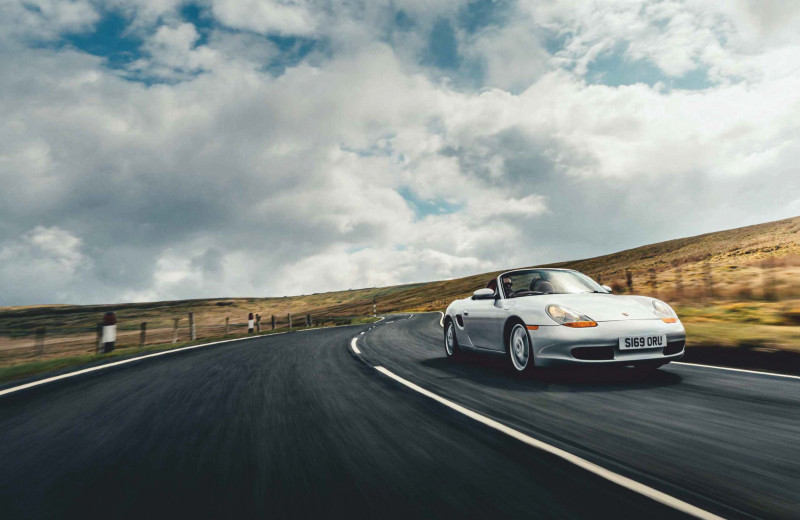
Conceived under then-new boss Wendelin Wiedeking, the Boxster achieved sales figures that say it all: in 1989 Porsche’s sales had slipped from around 40,000 units annually to 15,000; yet between 1996 and 2004, Porsche shifted 164,874 first-generation ‘986’ Boxsters alone, or around 20,000 each year.
'You end up laying in to all the dynamic reserves and performance, which makes every drive moreinvolving'
And this year Porsche’s entry-level sports car turns 25, putting its contribution back in the spotlight. So how much for this classic Porsche of such historical significance? Not much. Low five-figure budgets turn up some of the nicest examples, but photographer Dan Bathie paid just £3500 earlier this year for the car you see here. Of course it isn’t concours, but this manual 2.5 is appealingly finished in the same silver exterior and terracotta interior colours as the original Boxster Concept shown at the 1993 Detroit motor show, as well as early launch models, and presents as a smart and useable example. A bargain.
Drives well too: over the twists of the Pennines it offers great feedback and feels tight, delicate and nimble — if anything, even more enjoyable to chuck around given that it’s probably worth more in parts than whole.
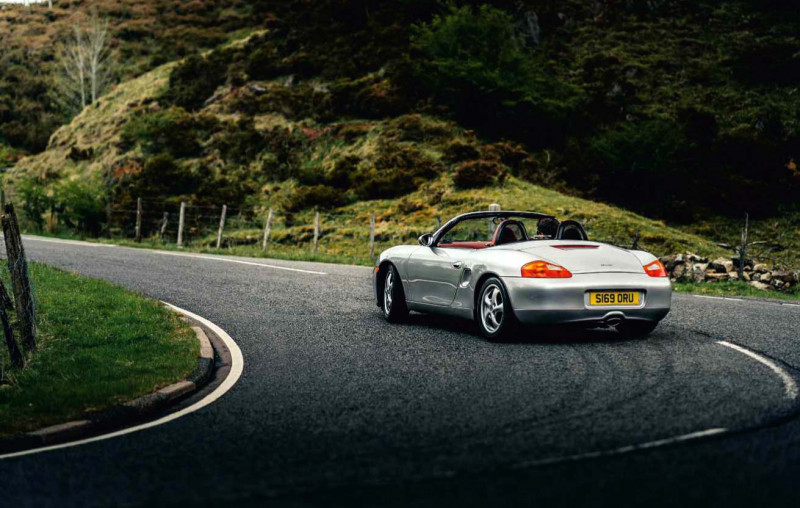
Open the door and you settle into a cabin that could be mistaken for a 911s: no surprise given the Boxster laid foundations for the 996-era 911, a model that marked the biggest shift in the 911s lifetime and shared 50% of the Boxsters parts, helping shave 30% from its bill of materials. In fact, from inside only three key details distinguish the two: the instrument binnacle features three dials rather than five, and a more playful typeface (like they’re saying you’ll have more fun in this car), the gearknob has five speeds not six, and over your shoulder there’s a bulkhead rather than plus-two seats.
The asymmetrical seating of the Boxster Concept’s interior is gone (tighter and more heavily bolstered on the driver’s side), as are the rotating ventilator fans, but fundamentals of the Stefan Stark design survive: it’s sporting and focused in here, but also entirely user-friendly with the Boxsters relatively low driving position (I’d prefer it lower still), great visibility, good comfort and pedals clearly set up by people who heel-and-toe their way to the shops, this car’s optional leather dash (it covers crinkly hard plastic beneath) is a welcome upgrade, too.
A latch on the header rail unclips the fabric roof, and a press of a button has it electrically whirring away beneath the metal tonneau cover in around ten seconds, these early cars have plastic screens that can fold and crack during operation, so owner Bathie recommends the ‘Boxster chop’, a light karate chop on the screen to ease out creases as the roof motors back.

Turn the key and this car starts with a lovely dry, crisp rasp that’s far more pronounced than usual thanks to an exhaust silencer bypass that pipes flat-six music direct to the countryside, the sound and the promise of a 911-lite flat-six is central to this car’s appeal, so it’s incredible to think that Porsche had mulled a four-cylinder developed by Audi, thankfully Audi’s quote was so high that Porsche settled on a detuned version of the 911s water-cooled flat-six, turned through 180° with the gearbox behind it. With the Boxster on sale a year before the 996, its M96 engine became the first water- cooled boxer engine ever fitted to a Porsche.
Porsche unveiled the Boxster Concept at Detroit because the US accounted for 60% of sales, but with the UK a crucial market it seems appropriate to start our road trip at Porsche Kendal. Why? Well, this is the UK’s oldest Porsche dealership: it began selling Porsches in 1957 and remains in the same family ownership. Dealer principal Ian Parker lets us pull into the workshop next to a couple of modern 718 Boxsters, and recalls the Boxsters impact; he even attended the dealer launch in the US. Adding a neat circularity, Parker joined the family firm in 1972 and experienced first-hand how the entry-level Porsche 924 helped the business recover following the 1970s recession, mirroring the Boxster effect two decades on.
'It pivots around your hips like a hulahoop round a Hawaiian dancer'
‘In the recession of the early 1990s you could sell at a price, but in the 1970s no-one wanted to know, the 924 was much maligned, but it was half the price of a 911 and a very good car — we sold about three of them for every 911,’ he recalls.
Business continued to thrive with the 944 and the 928 until the early 1990s recession, and eventually the Porsche range dropped to just the 993-era 911. ‘that was tricky and ultimately a harder period than the 1970s; not every dealer made it through,’ says Parker, ‘but the Boxster really got things going again, it was so good from day one. I remember the launch in Arizona with at least 60 or 70 cars there. Porsche arranged for police escorts and for all the traffic lights to be green, and everyone came back absolutely beaming — the car was so good to drive!’
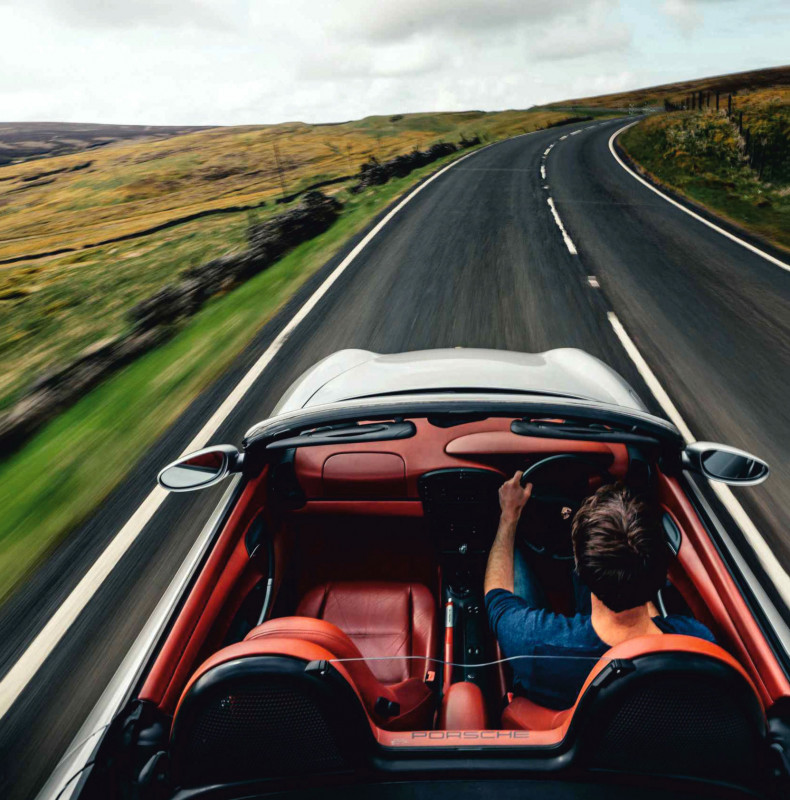
The Boxster cost £33,950 new, and Parker reveals that most were optioned to £40k; still expensive, he notes, if substantially below the incoming 996s £64k. Porsche Kendal’s first-year allocation quickly sold out, and it’s testament to Porsche’s continued growth that the Parker family’s dealership is about to move to a new, far larger site 12 miles south.
On his suggestion we largely skip the M6 to reach the Pennines, instead turning left out of the dealership on the A6. Soon Kendal’s outskirts are in our rear-view mirror as we discover a road that intersperses flicks of blind direction changes with long, well-sighted runs, the Boxster settles into a reassuring rhythm: nice ride on its 17-inch alloys (tiny 16s were standard), lovely fluid gearshifts and steering, prompt brakes and a sense that the Boxster is eager to change direction, if hard to unsettle and inherently well-balanced.
Squeeze the throttle and the engine builds from a mellow, bassy smoothness low down to a searing yowl above 5000rpm that’s indecently exotic given the price of entry, and flicks round to 6500rpm with a real zing. It’s one of those cars that feels fabulous even when you barely scratch the surface.
Crank it up and, crikey, not much performance though: there’s very little torque down low considering the cylinder count, the relatively generous 2.5-litre capacity and modest 1252kg kerbweight. You have to use all the revs and bounce up and down in your seat to overtake! The figures back that up, with a peak of 201bhp at 6000rpm and 177lb ft of torque that waits until 5000rpm to reveal itself.
'Squeeze the throttle and the engine builds from a mellow, basssmoothness to a searing yowl above 5000rpm'
Kneecapping performance was, of course, a way to safeguard the 911 (with 296bhp/258lb ft), given it cost so much more and is arguably the less nimble machine, with a rear- rather than mid-mounted engine. Later, the first-generation Boxster grew to 2.7 litres with 217bhp and 192lb ft partly thanks to a new two-stage intake (then 225bhp, and then 256bhp for the 3.2S), and, while the gear ratios were longer, an early 2.7 I drove earlier this year felt substantially more flexible and also revved a huge 600rpm higher, that’s the early Boxster I’d buy.
Porsche actually had its eye on the opposite end of the market before the Boxster, and planned the 989, a four-door 911 later reprised with the Panamera and developed under Ulrich Bez (who would go on to become boss of Aston Martin). For Porsche lifer and new R&D boss Horst Marchart, however, the maths didn’t add up, especially as the more affordable 928 was already sticking to dealer floors. Marchart was promoted to the board in 1991 after he pitched a cheaper mid-engined model, which won out over other entry-level suggestions, including a two-seat, detuned 911 pitched as a kind of modern 912.
‘We had to find the way to sell at least 30,000 units a year again,’ explains Marchart. ‘My idea was to go back to the roots. We didn’t have the Boxster yet; I just told the Board we’re going to take the 911 and come up with a new car, which will have the identical front end, and what we are going to vary is the mid-engined concept. Of course that’s easier said than done, but we got it done.’
That car became the Boxster, the first mid-engined Porsche since the 914, its name a portmanteau of ‘boxer’ engine and ‘roadster’. US-born Grant Larson designed both the Boxster Concept and the production car, following work on the 968 and 989. He also went back to the roots, inspired by earlier mid- engined models such as the 1950s 550 racer, its 718 RSK successor and the less curvaceous 914.
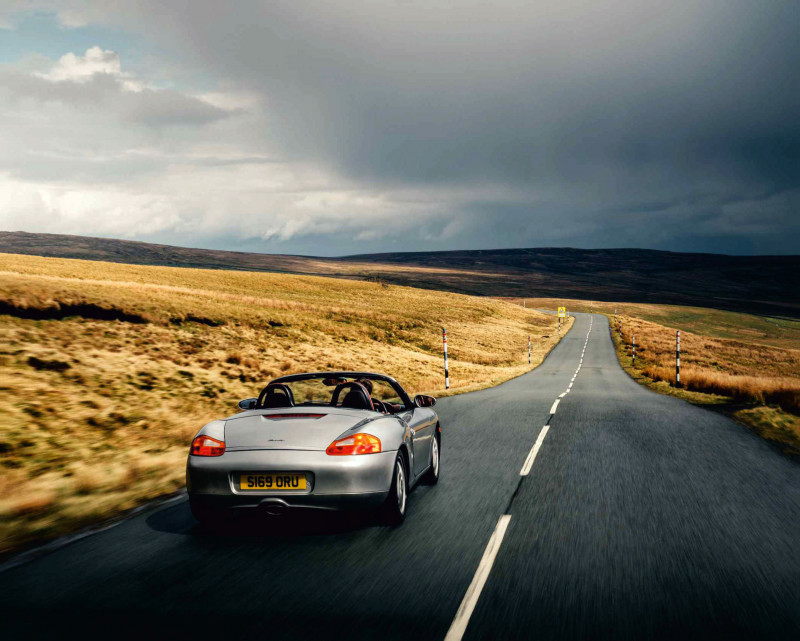
Larson is quick to credit clay modeller Peter Muller’s contribution. ‘He just said “Give me a sketch”, so I plastered the walls with drawings, and of course talked to my boss [Harm Lagaay]; we put little red dots on each of the areas that we thought could become the new Boxster,’ he recalls. ‘[Peter] started sculpting the clay model with this thing that looked like a cheese grater and the car just sort of blossomed from his hands’ Porsche had planned to manufacture the Boxsters bodyshell in aluminium, but reverted to more familiar steel given the short timescales and financial pressures.
Walking around the Boxster today is a reminder that this isn’t quite the uncorrupted passage from concept to production of, say, a MkI Audi but the cab-forward look, low bonnet and rear deck and shapely wings are clearly recognisable from the Concept, as is the central pea-shooter exhaust.
Production realities included the side intake moving far further up the flanks, and packaging a fabric roof. More significantly, the Boxster became ‘10-15% larger’ for production, and was always intended to share its doors, front wings, bonnet and windscreen angle with the 911 (the screen itself is actually a little lower). Larson reveals that the controversial ‘fried egg’ headlights were never supposed to be shared with the 911, but became a pragmatic solution as the necessary cost-savings became clear, ‘the modular headlamp was very important. [It] saved a lot of money, not only because of getting all the functions in one element, but also to make it very easy and faster to produce — especially faster to produce, because time on the production line was also money.’
Criticism of the ‘fried eggs’ led Porsche to facelift the Boxster with smoked indicator lenses (and to upgrade the 911s altogether), but today the early cars’ ‘gingicators’ are highly prized, as is their cable-operated throttle, valued for a perceived extra purity of response over the later fly-by-wire technology, as well as the purity of being able to throw one into the scenery without the shackles of stability control.
As we head east from Penrith on the A686, the rolling green landscape, dry-stone walls and more open stretches of road gradually give way to tighter curls of tree-shaded corners and then the wilder moorland landscape of Melmerby and beyond. It’s here that the Boxster really comes alive, its inherent sweetness unlocked by new Michelins all-round, and the Boxster’s impeccable balance largely overcoming its deficit of power given the constant stream of corners — when I asked Horst Marchart about the Boxster’s handling versus its performance compared with the 911, he answered that ‘in curvy passages where the full power of the car is not required, the Boxster was able to convince, even compared to the 911’. that’s certainly how it feels.
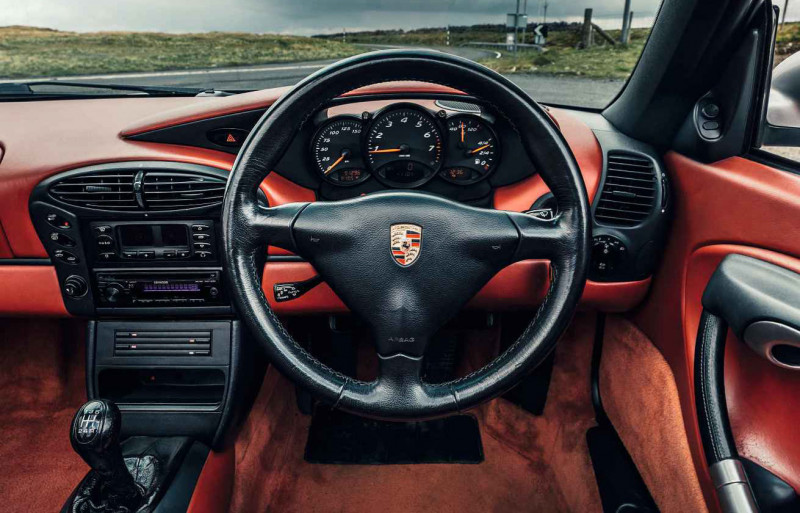
Front-end grip is so high, the steering so precise and the body so composed that you trust to go easier on the brakes and carry more momentum through bends — even then the tyres barely chirrup, nor is there any sense of weight transfer starting to drag the rear end round if you pitch it into a corner off-throttle, in large part because the flat-six is mounted both low and centrally. You end up just laying in to all the dynamic reserves and performance, which only makes every drive more involving — sweeping the steering into corners with big positive inputs, downshifting for power rather than driving on torque and generally monstering the flat-six as it sings away behind you.
There’s still mischief to be had, though, because the mid-engined balance lends an adjustability to the Boxster’s handling. It pivots around your hips like a hula-hoop round a Hawaiian dancer as you steer and lift the throttle to carve through sequences of bends, and once you’ve unsettled the rear it becomes nicely throttle-steerable, if lacking the fine control of a limited-slip differential (though in truth this is the talk of a motoring journalist enjoying someone else’s car rather than something you’ll often miss).
Eventually we climb up to the look-out at Hartside Pass, and stop to gaze out over a landscape that unfurls towards the Solway Firth far beyond as the Boxster ticks and cools in the afternoon breeze.
Twenty-five years ago the Boxster was the entry-level model that got Porsche back on track. Today it is arguably undervalued in terms of both the pivotal role it played in that revival, and the price you’ll pay to enjoy the enduring vitality of its mid-engined dynamics.
Quite possibly, there’ll never be a better time to buy.
THANKS TO Boxster owner Dan Bathie
Clockwise, from top left Octane meets Ian Parker at Porsche Kendal, the UK’s oldest Porsche dealership; push a button and the hood lowers itself; wind deflector keeps progress buffet-free; lairy cornering attitude is there for the asking, though not mandatory.
Clockwise, from top right Looks good in profile even with the hood up; interior has matured to become a period piece though still with a dash of Porsche logic; Horst Marchart had to persuade the senior management board; Marchart (on left) with designer Grant Larson — and the original Boxster Concept.
TECHNICAL DATA FILE 1999 Porsche Boxster 986
- Engine 2480cc flat-six, DOHC per bank, 24-valve, fuel injection
- Max Power 201bhp @ 6000rpm
- Max Torque 177lb ft @ 5000rpm
- Transmission Five-speed manual, rear-wheel drive
- Steering Power-assisted rack and pinion
- Suspension
- Front: MacPherson struts, coil springs, anti-roll bar
- Rear: multi-link, coil springs, telescopic dampers, anti-roll bar
- Brakes Discs
- Weight 1252kg
- Top speed 152mph
- 0-60mph 6.9sec
NOT QUITE A 911.
Sharing structures saved Porsche — but how does the Boxster compare?
I’ve owned my 996 Carrera 2 for over three years, and met Boxster owner Dan Bathie at Porsche Kendal for a back-to-back comparison. Both are the earliest iterations of Porsche’s first water-cooled flat-six sports cars, and produce the lowest power outputs of their types: 2.5 litres, 201 bhp and 177lb ft for the Boxster; 3.4 litres, 296bhp and 258lb ft for the 911.
Performance is the biggest differentiator, in terms of low-rpm flexibility, acceleration and the reach of the 911 's engine to beyond 7000rpm. Even with a much taller second gear, the 911 rips where the Boxster builds.
Dynamically the 911 has a more substantial feel — not just weight, though it does feel heavier, but also a more structurally solid and tighter feel to its coupe body. A rear-mounted engine means the 911 doesn’t pivot around your hips as intuitively as the mid-engined Boxster; it can seem a little more stubborn to change direction, and there’s more of a learning process if you’re unfamiliar with 911s — it’s easier to be clumsier and understeer, and it takes time to appreciate and exploit the available traction. But when you learn to really sweep the steering into quick corners off-throttle, use the weight of the engine to cancel any understeer and then the traction to power out, everything clicks.
The Boxster’s fabulous, and a veritable bargain at half the value of the equivalent 911 — but there’s no doubt that the rewards are there if you can stretch to big brother.


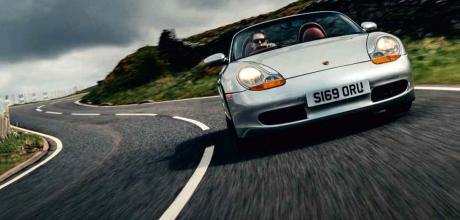
Fancy a bit of internet window shopping?
It will come as no surprise that, being obsessed with cars, the Octane team spends plenty of time discussing the motors we would like to snap up while we still can, preferably when they are right at the bottom of their ‘depreciation curve’. Of course, all too often such discussions end with an internet search and the realisation that prices have bounced and we have already missed the boat. Possibly even more often, furious activity is followed by a cooling-off period and then it all turns out to have been a flight of fancy anyway.
We are all guilty of this, though associate editor Glen Waddington is in a different league — it is a very good thing he isn’t so fickle in real life — and I’ll bet plenty of you are, too. One day we might be salivating over Lada Nivas and Fiat X1/9s, the next strangled bad-taste Corvettes and Renault Twingos. Obviously, even the Octane old ’uns still like a bit of power beneath their feet, so cars with a bit of pep tend to come to the fore, whether the tepid hatches that seem unwittingly to have become my speciality (Alfa 145 Cloverleaf and Ford Focus ST170) or the JDM specials that Matthew Hayward is always ogling. Oh, and the hot Renaults. All of them. Always. For everyone.
Either way, these listings lustings usually tend towards the modern classics, perhaps simply because there are so many still to bottom out in a less mature market, maybe because we all mentally categorise them as a cheap daily driver to enjoy while we are still permitted to, or it might just be that there is such a glut of brilliant millennial drivers’ cars out there that can be picked up for a relative song today.
There are advocates for every one, of course, but all of us (even Glen) keep coming back to the Porsche Boxster, a mere 25 years old but already the saviour of the company and a sports car watershed, This is a car that would be no less impressive if launched today, yet can be bought for the price of the cheapest new car on sale.
Sure, plenty would prefer a Cayman S, but the extra spend is as hard to justify as for a Rover P5B coupe over a saloon, The Boxster ticks all the boxes for us and we reckon now is its moment, so that is why we celebrate it this month. If it doesn’t tick all your boxes, don’t worry: we have some alternative suggestions that might.